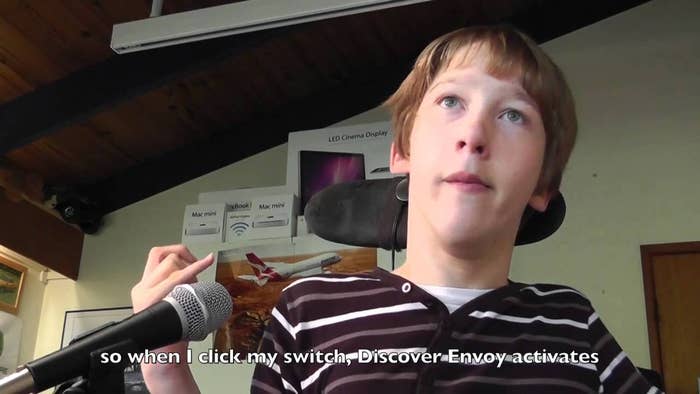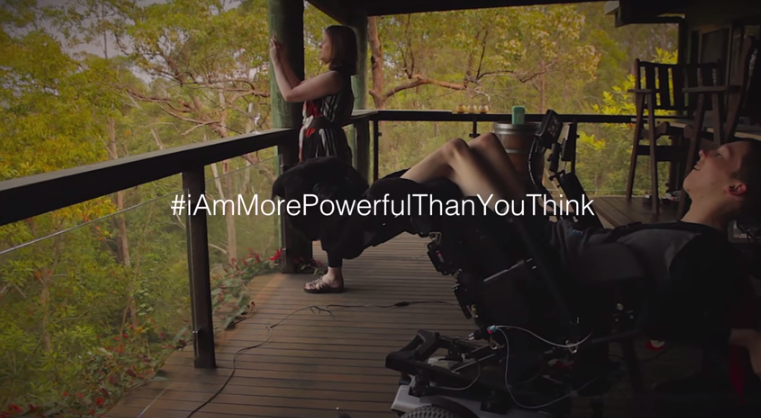
On April 3, 2012, Christopher Hills posted a clip to his YouTube account. In the three-minute video, Hills squarely addresses his webcam from what looks like his childhood bedroom. On the white walls behind him are a smattering of posters of high-end sports cars, jets, and rocket ships — it’s the kind of teen bedroom that’s been home to countless YouTube rants, confessions, and reviews. But Hills’s demeanor is serious as he begins talking about the rise of smartphones, tablets, and touchscreen technology. “I am going to show you how touchscreens help me,” he says to the camera. Moments later, we see Hills in his wheelchair, facing a desk with an iPad perched atop. We watch Christopher, a resident of Queensland, Australia, move forward slightly, struggle for a moment, and then pause, unable to reach the iPad screen.
“I keep reading things about the touchscreen overtaking the mouse and keyboard and this really scares me,” he confesses into the camera. Hills’ Athetoid cerebral palsy has left him unable to walk or use his hands, and, at that moment in 2012, his fears were understandable. "I think touchscreens are an amazing technology, but my disability means I can't use my hands — so let's face it,” he says. The video — shot, edited, and posted by Hills — is an arresting reminder of an alarming truth: Technologies aimed at, hyped by, and marketed toward an able-bodied majority often overlook the eager constituency of the disabled.
For Hills, that fear and frustration began to subside after 2013. That’s when Apple introduced Switch Control, an accessibility feature that helps those with limited mobility to navigate, select, and manipulate iOS touchscreen devices with the click of a button, movement of the body, or any number of alternative inputs (blowing into a tube, etc.). Launched as a feature in iOS 7, Switch Control gave Christopher and thousands of others the opportunity to finally take command of touch displays inside Apple’s applications as well as third-party programs, like games and browsers, without the use of expensive third-party devices. For Hills, though, nothing was as satisfying or memorable as being able to perform the most elemental functions.
“The thing that comes to mind is the day I made my first phone call. I was 15. I was able to call mum at work. As you can imagine, this was a very big thing,” Hills told BuzzFeed News of using Switch Control for the first time.
For decades, accessibility technology has seemed an afterthought for the world’s most powerful technology companies, leaving those who require additional assistive features with largely outdated technology or, in the case of touchscreens, no access at all.” The biggest problem used to be a general lag in software,” Elizabeth Ellcessor, a professor at Indiana University who specializes in digital media and accessibility studies told BuzzFeed News. “Software would come out and companies wouldn’t build in accessibility features for years and by that time the piece of software would be out of date,” she said.
For Hills, a gadget fan, the lag was excruciating. “When the iPhone came out, I was using these devices that were designed in the time of the Apple Newton and had not improved since then,” he told Buzzfeed News.
But the problems with assistive tech innovations were more than just inconvenient. The Dynamo, an assistive switching tool and universal remote for desktop computers that Hills used before Switch Control, cost thousands of dollars and could only serve the most basic communications functions. “Typing on the PC was possible, but it was extremely slow and, as a result, I always needed to have a [caregiver], mostly Dad, to help me whenever I needed to type more than just a few words,” Hills said.
Around the time Hills made his video about touchscreens, he was beginning to worry that he might never get to play games or even make phone calls like millions of his peers; the touchscreen revolution, he feared would leave him behind. “I knew how hard it was finding assistive technology solutions to control my desktop and here was a completely new thing and it just didn’t seem like anybody would be able to come up with a solution very quickly,” he wrote in an email to BuzzFeed News.
But in the mid-2000s, Apple began a full overhaul of its assistive program with an emphasis on building accessibility features into products from the ground up, rather than adding them into previously developed software. In 2005, the company created a built-in voice reader called VoiceOver for its desktop computers, which it incorporated into the iPhone in 2009, allowing visually impaired iPhone users to navigate the touch device using voice controls. The company also began courting users of all abilities, focusing on previously underserved constituencies to ask them what features needed improvement and what to build next. As part of this initiative, Apple engineers also underwent mandatory accessibility training.
Apple is not alone in this space. In 2005, Google began funding research projects geared toward accessibility issues in areas such as speech, mobile, and human-computer interaction; others, like Microsoft, have also begun work to include more accessibility features in initial shipped versions of software and hardware, in order to bake assistive tech in from the beginning with features like text narration, magnification, password speaking, and high contrast text.
But for all that progress, and for all the mostly happy stories from people like Hills, companies such as Apple still have plenty to do if they are to be truly accessible. The costs of accessible tech, while much lower than they were five or ten years ago, are still expensive for disabled customers with limited financial resources, and while Apple’s Voice Control and Switch Control features are free, third-party assistive tech can often be prohibitively costly (a Freedom Scientific braille display monitor for those with vision impairments runs $7,795 for an 80 cell display.) The disparate nature of the applications inside the App Store and lack of standardized accessibility requirements for developers has left advocates in some disabled communities frustrated by the quality of numerous popular apps.
In January, a blog post from a concerned blind user noted that "Apple does have a fantastic accessibility story" but that "they’re on the verge of badly trumping that trust many people with disabilities put in them by delivering such poor quality updates that make it virtually impossible to take advantage of [accessibility] features in full force." And last July, the National Federation of the Blind, as a part of an ongoing campaign, publicly pushed Apple to bring accessibility requirements to the App Store, noting that “'it’s time for Apple to step up or we will take the next step" (Apple has since begun to address such complaints). That said, Mark A. Riccobono, president of the National Federation of the Blind, has repeatedly spoken out in support of Apple’s accessibility efforts, noting that, “Apple has done more for accessibility than any other company to date.” These dual feelings hint at an insidious tension for those advocating for assistive tech: They want to hold tech’s leaders accountable, but fear alienating or overstepping their bounds with their biggest allies.
And for his part, Hills said he “hope[s] software developers continue to do more. There are apps I still can’t access, such as some games," he said, adding that "it would change my life if there was a technology that could help me directly overcome my speech difficulties.”

Less than three years after Hills posted the the touchscreen video, his life is dramatically different. He no longer needs to spend thousands of dollars on new, quickly obsolete devices to use an iPhone or iPad and is no longer forced to rely on a caregiver for tasks like typing an email. He is now an Apple-certified Final Cut Pro editor and has his own video production and editing business that he runs out of his house. And his YouTube page is home to dozens of videos geared toward educating others about accessibility tech, including Switch Control. In his spare time, Hills speaks to training and support groups and writes guest blog posts about his experiences and how to best take advantage of assistive technology.
Features like Switch Control work in practical and measurable ways to lower costs for the disabled and work to bring more and more people not only online, but further into a culture that overlooked their technological needs. Giving more people the necessary tools means not only offering up the vast and rich world of internet and all that modern software and hardware have to offer to a wider audience, it also means widening the spectrum and potential of innovation through inclusion. “I like to think about this kind of technology less like a light switch and more as a set of possibilities,” Ellcessor said. “Accessibility is about creating the possibility for those with particular bodily impairments to participate and engage in culture and in whatever ways they want to.” That possibility, and the participation that it fosters, ultimately mean adding more diverse voices into the culture.
Maybe most important though — at least for Hills — it’s about a feeling of liberation that’s hard for any company to measure in an earnings report or tech specs sheet. “These tools have allowed me to come out of my shell and make my own way in the world,” he wrote in an email to BuzzFeed News. “From communication and environmental control, to work and learning, and recreation and entertainment. Combined with the internet, Switch Control has allowed me to engage with the world more than ever before and to participate and contribute in ways that I never really thought would be possible.” Ultimately for Hills, it’s about a personal sense of dignity that comes from being able to share his voice and passion with the world.
Now, more than two years after posting about touchscreens, his videos have taken on a different, bolder tone. In one clip from last September, Hills has swapped the bedroom and posters for HD footage, complex, staged shot compositions, lens tinting, and a powerful score. The clip opens with a woman standing on a balcony, casually taking pictures of the setting sun through the trees on her iPhone. Moments later, Hills comes onto the balcony and angles his mounted iPhone toward the sunset. Using the toggling button located on his wheelchair’s headrest, Hills begins to take photos of his own along with the woman as the music swells. At its crescendo, the screen cuts to black and the screen flashes a final message: #iAmMorePowerfulThanYouThink. The tagline is Hills’s own reference to Apple’s 2014 "Powerful" advertisement as well as a crucial reminder to those building, using, and writing technology products today; and, as anyone who’s ever watched one of Hills’s videos knows, it’s also the truth.


